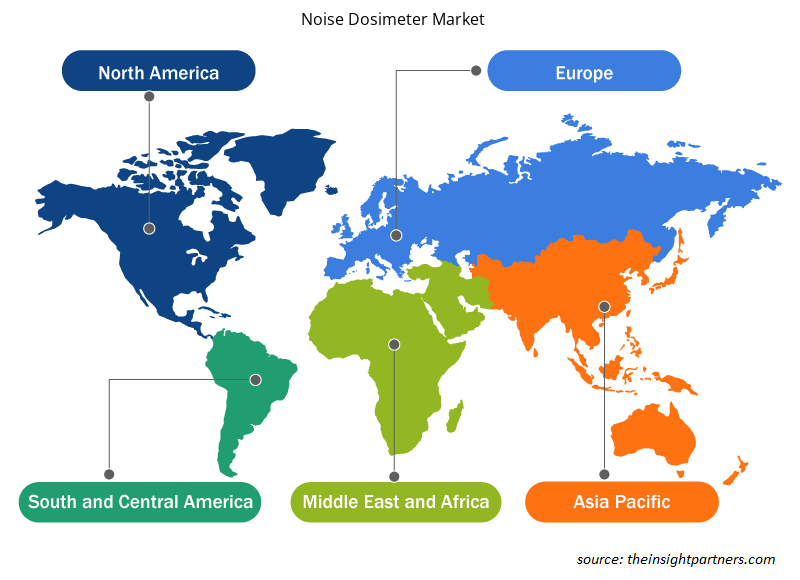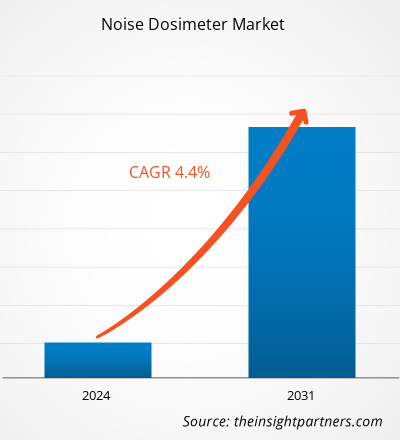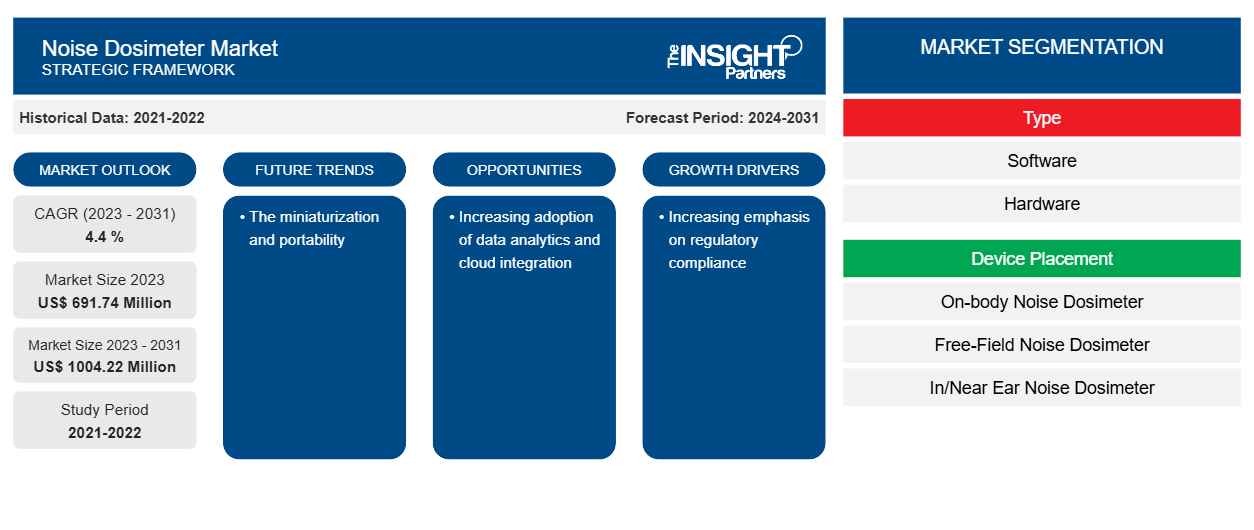Si prevede che la dimensione del mercato dei dosimetri di rumore raggiungerà 1004,22 milioni di dollari entro il 2031 da 691,74 milioni di dollari nel 2023. Si prevede che il mercato registrerà un CAGR del 4,4% nel periodo 2023-2031. È probabile che la miniaturizzazione e la portabilità rimangano una tendenza chiave nel mercato.
Analisi di mercato del dosimetro di rumore
La domanda del mercato è attribuita al crescente utilizzo di dosimetri di rumore personali. Per i professionisti della salute e della sicurezza e gli igienisti industriali di oggi, le misure del rumore sul posto di lavoro sono essenziali. Molti stabilimenti di produzione nel mondo industrializzato hanno ancora livelli elevati di rumore. Diverse regioni preferiscono utilizzare un dispositivo personale per verificare la dose di rumore di un lavoratore. Allo stesso tempo, altre nazioni utilizzano una combinazione di misuratori di livello di rumore portatili e un numero inferiore di dosimetri di rumore personali. Per una persona impegnata che potrebbe avere numerosi rischi aggiuntivi da affrontare in ufficio, i vantaggi di un dosimetro di rumore personale sono molti sistemi che sono attualmente in uso con quelli nuovi.
Panoramica del mercato dei dosimetri di rumore
Non esiste un metodo o un metodo unico per misurare il rumore professionale. I professionisti della sicurezza e della salute dell'udito possono utilizzare vari strumenti per misurare il rumore e possono scegliere tra diversi strumenti e software per esaminare le loro misurazioni. La scelta di uno strumento specifico e di un approccio per analizzare e misurare il rumore occupazionale dipende da vari fattori, non ultimo dei quali sarà il motivo della misurazione e l'ambiente in cui verrà effettuata la misurazione. Il processo di misurazione del rumore con un fonometro è relativamente semplice quando i livelli di rumore sono costanti e quando il lavoratore rimane sostanzialmente fermo durante il turno di lavoro. Un dosimetro del rumore è consigliato per misurare l'esposizione al rumore di un lavoratore quando i livelli di rumore sono variabili o intermittenti.
Personalizza questo report in base alle tue esigenze
Riceverai la personalizzazione gratuita di qualsiasi report, comprese parti di questo report, o analisi a livello nazionale, pacchetto dati Excel, oltre a usufruire di grandi offerte e sconti per start-up e università
-
Scopri le principali tendenze di mercato in questo rapporto.Questo campione GRATUITO includerà analisi di dati che spaziano dalle tendenze di mercato alle stime e alle previsioni.
Driver e opportunità del mercato dei dosimetri di rumore
Crescente attenzione alla conformità normativa
Il dosimetro di rumore multicanale consente la misurazione simultanea di tutti i parametri necessari per valutare l'esposizione al rumore dei lavoratori e per selezionare la protezione dell'udito utilizzando SNR, HML o bande di ottava. Ogni canale può essere configurato individualmente per soddisfare qualsiasi standard di misurazione del rumore, regolamento o linea guida. Ciò consente al dosimetro di misurare un'ampia gamma di dati e fornire le informazioni necessarie per soddisfare qualsiasi standard di rumore occupazionale. Pertanto, con la crescente enfasi sulla conformità normativa, la domanda di dosimetri di rumore è in aumento.
Crescente adozione di analisi dei dati e integrazione cloud
La prossima grande rivoluzione nella misurazione del rumore probabilmente modificherà il modo in cui il rumore viene misurato e monitorato. L'integrazione della tecnologia cloud nella magnitudo del rumore è un momento spartiacque per il settore che promette di sviluppare il modo in cui le organizzazioni in tutto il mondo proteggono i propri dipendenti e l'ambiente dai rischi di esposizione a rumore estremo. Gli osservatori del rumore connessi al cloud possono essere installati in varie posizioni in un sito o in più siti, coprendo un'area geografica il più ampia possibile. La tecnologia cloud supera le sfide incontrate dalle operazioni multi-sito e promette di rendere il monitoraggio del rumore più efficiente e accessibile rispetto ai metodi convenzionali. Pertanto, la crescente adozione di analisi dei dati e integrazione cloud sta creando maggiori opportunità per il mercato.
Analisi della segmentazione del rapporto di mercato del dosimetro di rumore
I segmenti chiave che hanno contribuito alla derivazione dell'analisi di mercato del dosimetro di rumore sono la tipologia, il posizionamento del dispositivo e l'applicazione.
- In base al tipo, il mercato dei dosimetri di rumore è diviso in hardware e software. Il segmento software ha detenuto una quota di mercato maggiore nel 2023.
- In base al posizionamento del dispositivo, il mercato è suddiviso in dosimetri di rumore da applicare sul corpo, dosimetri di rumore in campo libero e dosimetri di rumore in prossimità/intra-auricolare.
- In base all'applicazione, il mercato è segmentato in aerospaziale e difesa, automobilistico, edile, fabbriche e imprese.
Analisi della quota di mercato del dosimetro di rumore per area geografica
L'ambito geografico del rapporto di mercato sui dosimetri acustici è suddiviso principalmente in cinque regioni: Nord America, Asia Pacifico, Europa, Medio Oriente e Africa, e Sud e Centro America.
L'APAC domina il mercato dei dosimetri di rumore. La stima del rumore industriale differisce sostanzialmente da quella del rumore dei trasporti. Contrariamente al rumore dei trasporti, che può essere proiettato utilizzando una raccolta di set di dati di input, non ci sono approcci simili per il rumore industriale. L'unico modo per determinare quanto emette una fonte industriale è determinarlo. L'aumento delle emissioni di rumore industriale e l'acuta necessità di controllarle sta causando l'adozione di dosimetri di rumore in diversi settori nell'APAC.
Approfondimenti regionali sul mercato dei dosimetri di rumore
Le tendenze regionali e i fattori che influenzano il mercato del dosimetro di rumore durante il periodo di previsione sono stati ampiamente spiegati dagli analisti di Insight Partners. Questa sezione discute anche i segmenti e la geografia del mercato del dosimetro di rumore in Nord America, Europa, Asia Pacifico, Medio Oriente e Africa e America meridionale e centrale.

- Ottieni i dati specifici regionali per il mercato dei dosimetri di rumore
Ambito del rapporto di mercato del dosimetro di rumore
| Attributo del report | Dettagli |
|---|---|
| Dimensioni del mercato nel 2023 | 691,74 milioni di dollari USA |
| Dimensioni del mercato entro il 2031 | 1004,22 milioni di dollari USA |
| CAGR globale (2023-2031) | 4,4% |
| Dati storici | 2021-2022 |
| Periodo di previsione | 2024-2031 |
| Segmenti coperti |
Per tipo
|
| Regioni e Paesi coperti |
America del Nord
|
| Leader di mercato e profili aziendali chiave |
|
Densità dei giocatori del mercato del dosimetro di rumore: comprendere il suo impatto sulle dinamiche aziendali
Il mercato del dosimetro acustico sta crescendo rapidamente, spinto dalla crescente domanda degli utenti finali dovuta a fattori quali l'evoluzione delle preferenze dei consumatori, i progressi tecnologici e una maggiore consapevolezza dei vantaggi del prodotto. Con l'aumento della domanda, le aziende stanno ampliando le loro offerte, innovando per soddisfare le esigenze dei consumatori e capitalizzando sulle tendenze emergenti, il che alimenta ulteriormente la crescita del mercato.
La densità degli operatori di mercato si riferisce alla distribuzione di aziende o società che operano in un particolare mercato o settore. Indica quanti concorrenti (operatori di mercato) sono presenti in un dato spazio di mercato in relazione alle sue dimensioni o al valore di mercato totale.
Le principali aziende che operano nel mercato dei dosimetri di rumore sono:
- Bruel & Kjaer
- Casella (IDEAL INDUSTRIES,INC.)
- CESVA INSTRUMENTS SLU
- 3 milioni
- SVANTEK
- Ricerca Cirrus plc
Disclaimer : le aziende elencate sopra non sono classificate secondo un ordine particolare.

- Ottieni la panoramica dei principali attori del mercato dei dosimetri di rumore
Notizie e sviluppi recenti sul mercato dei dosimetri di rumore
Il mercato dei dosimetri di rumore viene valutato raccogliendo dati qualitativi e quantitativi dopo la ricerca primaria e secondaria, che include importanti pubblicazioni aziendali, dati di associazioni e database. Di seguito sono elencati alcuni degli sviluppi nel mercato dei dosimetri di rumore:
- TSI ha introdotto le ultime novità in fatto di dosimetria del rumore con il lancio del nuovissimo Quest™ Edge 7 Personal Noise Dosimeter. Negli ambienti di lavoro rumorosi, proteggere l'udito dei lavoratori è fondamentale per rimanere sani e salvi. Il TSI® Quest™ Edge Personal Noise Dosimeter è uno strumento potente e intuitivo progettato per identificare le minacce di perdita dell'udito e informare la progettazione di programmi di protezione dell'udito e controlli ingegneristici. (Fonte: TSI, comunicato stampa, luglio 2023.)
- Presentazione del NUOVO dosimetro di rumore personale SKC NoiseCHEK L'eccessiva esposizione a livelli elevati di rumore sul posto di lavoro può causare perdita dell'udito e altri problemi di salute nei lavoratori ed è quindi regolamentata dagli standard di esposizione al rumore stabiliti da Safe Work Australia. Utilizzare l'attrezzatura di sicurezza appropriata per garantire che l'esposizione al rumore non superi mai la media di 85 decibel su 8 ore o il picco di 140 decibel è fondamentale per mantenere il tuo team al sicuro. (Fonte: SKC NoiseCHEK, comunicato stampa, settembre 2023)
Copertura e risultati del rapporto sul mercato del dosimetro di rumore
Il rapporto "Dimensioni e previsioni del mercato del dosimetro di rumore (2021-2031)" fornisce un'analisi dettagliata del mercato che copre le seguenti aree:
- Dimensioni e previsioni del mercato dei dosimetri di rumore a livello globale, regionale e nazionale per tutti i principali segmenti di mercato coperti dall'ambito
- Tendenze del mercato dei dosimetri di rumore, nonché dinamiche di mercato quali driver, restrizioni e opportunità chiave
- Analisi dettagliata delle cinque forze PEST/Porter e SWOT
- analisi di mercato del dosimetro di rumore che copre le principali tendenze di mercato, il quadro globale e regionale, i principali attori, le normative e i recenti sviluppi del mercato
- Analisi del panorama industriale e della concorrenza che copre la concentrazione del mercato, l'analisi della mappa di calore, i principali attori e gli sviluppi recenti nel mercato dei dosimetri di rumore
- Profili aziendali dettagliati
- Analisi storica (2 anni), anno base, previsione (7 anni) con CAGR
- Analisi PEST e SWOT
- Valore/volume delle dimensioni del mercato - Globale, Regionale, Nazionale
- Industria e panorama competitivo
- Set di dati Excel
Report recenti
Testimonianze
Motivo dell'acquisto
- Processo decisionale informato
- Comprensione delle dinamiche di mercato
- Analisi competitiva
- Analisi dei clienti
- Previsioni di mercato
- Mitigazione del rischio
- Pianificazione strategica
- Giustificazione degli investimenti
- Identificazione dei mercati emergenti
- Miglioramento delle strategie di marketing
- Aumento dell'efficienza operativa
- Allineamento alle tendenze normative























 Ottieni un campione gratuito per - Mercato dei dosimetri di rumore
Ottieni un campione gratuito per - Mercato dei dosimetri di rumore